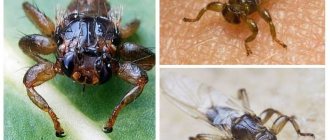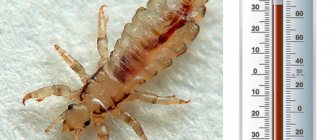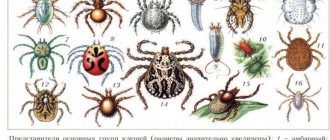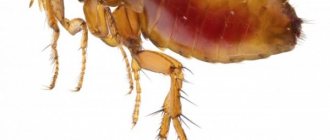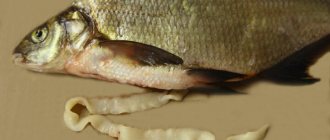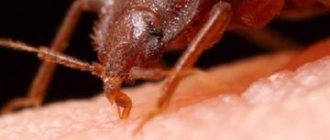General information about ticks
A tick is a blood-sucking insect that is a carrier of various deadly diseases.
The parasite's body produces an anesthetic substance that helps hide the moment of the bite. Through a wound caused by an infected insect, bacteria and viruses enter the bloodstream and spread throughout the human body. Ticks are most active in spring and summer. Habitats: mountains, forests, areas with tall grass. Ticks can also bite pets.
Scabies
This disease is rare now, but we should not forget about it. It is caused by scabies mites. You can only catch them through direct contact (including sexual contact) with an infected person. Clothing and household items are not involved in the process. Having landed on a healthy person, the female parasite, like a mole, immediately begins to dig in the skin. Productivity – up to 5 mm per day. In half an hour she manages to completely disappear into her hole. What’s interesting is that scabies mites don’t care whether their victim is a fan of cleanliness or hasn’t been washed for a month. They live on everyone. Signs of damage include rash, itching, broken lines (scabies holes or burrows). However, there are cases when such symptoms are absent. Favorite places to move are between the fingers and toes, genitals, and wrists. The rash starts there and then spreads throughout the body.
It is not scabies itself that is scary, but its complications. Thus, half of the patients experience dermatitis and purulent inflammation, and in some, especially weakened people, pneumonia, erysipelas, internal abscesses and other diseases occur with scabies. How to kill a subcutaneous tick? For this purpose, ointments with benzyl benzoate, lindane, and melathion are used. The drug "Ivermectin" has proven itself well.
Animals also have scabies mites, but they are not transmitted to humans.
Why are they dangerous?
The main danger of ticks is that they harm human health. Ticks are ectoparasites and causative agents of natural focal diseases. Pests are capable of transmitting various pathogens through the process of sucking blood.
Diseases
The most common diseases carried by ticks are borreliosis, ehrlichiosis and encephalitis. Infections are severe and can cause disability. As a rule, the diseases are chronic in nature and have a long rehabilitation period of up to a year. In addition to the diseases listed above, ticks carry:
- spotted fever;
- tularemia;
- babesiosis;
- tick-borne typhus
The variety of linen mites is not a blood-sucking pest, but these insects are also dangerous to humans. Microscopic excrement of insects along with dust penetrates the lungs and provokes the development of allergic reactions. In combination with a cold, allergies can cause bronchial asthma.
Allergy symptoms
The manifestation of disease symptoms depends on the pathogen that enters the human body after an insect bite. Since pests carry a large number of diseases, each of them is characterized by individual symptoms. In particular:
- Borreliosis is characterized by the appearance of migraines, general fatigue of the body, fever, attacks of nausea and vomiting. The most pronounced sign of the disease is a rash on the skin in the form of a ring-shaped redness.
- Tick-borne encephalitis causes a sharp increase in temperature to 39 degrees. Other symptoms include muscle soreness, vomiting and migraines.
- Ehrlichiosis is characterized by a sudden increase in body temperature and chills, joint pain, and a feeling of malaise. In severe cases, a skin rash appears.
- Symptoms of tick-borne relapsing fever develop gradually over a couple of weeks. Primary signs are insomnia, lack of appetite and feeling weak. Subsequently, the temperature rises, pain in muscles and joints occurs, and a severe rash forms on the skin.
How to kill a tick
If the parasite has bitten, but there is no opportunity to go to the hospital to examine it for the presence of pathogens, then the parasite must be destroyed. But not every person knows how to kill a tick found on their body. The surface of the insect consists of a chitinous shell, which is quite difficult to crush with fingers, and during action it can slip out.
It is important to remember that squashing a tick with your fingers or fingernails risks transmitting infection. There may be cuts and cracks on the hands through which the pathogen can enter the body.
Crushing an insect is not as easy as it seems, and such an action is dangerous, so you should familiarize yourself with methods for safely removing it from the body, as well as methods for destroying it.
The tick should not be released into the wild, as it will continue to search for its victim. In order to properly destroy the parasite, you must use the following tips:
- if a parasite is found on the surface of clothing, it must be thoroughly treated with hot water and powder, since ticks die from high temperatures;
- place it in the microwave in a closed jar and heat for 5–10 minutes;
- crush it using a large stone, after sticking adhesive paper or tape on it;
- burn at the stake using a lighter or matches.
It is impossible to kill a tick with water, but if there are no other options, then the parasite can be flushed down the toilet. But you won’t be able to drown it; the parasite does not die in water, so vinegar or bleach should be used as a liquid. You can also kill the parasite using alcohol; to do this, you need to stick tape on the tick and lower it into a container with alcohol, cover with a lid and wait until the insect dies.
Many people are interested in whether it is possible to crush a tick with your fingers? If you find it on your body or clothing, you should not rush to crush it with your hands, as this is fraught with serious consequences. You should not touch the parasite with your bare hands, as there is a high risk of transmitting the infection. There may be cracks or scratches on the fingers into which the pathogen can easily enter.
When crushed, the contents of the parasite get on your hands, and without washing your hands, it can be carried into the eyes, mouth, nose or other mucous membranes. You can remove the tick using a cloth, napkin or container. The clothes where the parasite was sitting must be washed in hot water.
Effective methods of destruction
The parasite removed from the house must be killed. It is useless to destroy a tick by trying to drown it in water; it can only drown in a container with table vinegar, bleach or alcohol with the lid tightly closed.
Also, under no circumstances should you crush ticks with the sole of your shoes or your nails. The most effective and optimal way to kill blood-sucking insects is to burn them. To do this, the parasite should be carefully picked up with tweezers and set on fire or thrown into the fire. This is a guarantee that he will definitely die.
Antibiotics for tick bites
Other ways to destroy a crushed tick:
- place it in a hermetically sealed container and heat it in a microwave oven at maximum power;
- wrap the insect tightly and tightly with tape and leave it - after a while the parasite dies from lack of air and hunger;
- wrap the blood-sucking parasite with a thick napkin or tape and kill it with a hammer or stone - this is the only way to destroy the hard chiton cover of the tick;
- wrap the tick with duct tape and flush it down the toilet.
After crushing bed mites, all bedding should be left in the dryer in hot air for several hours - all remaining larvae and eggs die. After this, the laundry should be washed thoroughly, dried again and ironed with a hot iron. The same should be done if you find a dust mite on clothing or a soft toy.
The most effective way to kill a tick is to burn it.
How to get rid of a parasite on the body
The tick is a dangerous insect that can cause serious harm to human health. It can cause infection with the following diseases:
- ehrlichiosis;
- tick-borne typhus;
- borreliosis (Lyme disease);
- tick-borne encephalitis.
Having found a vulnerable spot, the parasite inserts its proboscis into the skin, then its jaw and dives deep with its head. If removed incorrectly, there is a risk of damaging the insect and leaving the head buried under the skin. During the rupture of the body, its contents enter the human body along with the existing infectious agent. For the same reason, you should not crush the parasite with your hands.
It is not recommended to use kerosene or oil to extract the insect; if there is a lack of oxygen, the parasite can release infected fluid into the wound.
How to remove a tick if it is deep in the skin? There are several safe and easy ways to remove the parasite, these include:
- Pull it out using a curved hook tool. To do this, you need to pick it up with your teeth and carefully pull out the body without pressing on it.
- Make a loop from the thread, drape it over the parasite’s body and pull it out with swaying movements.
- Removal with tweezers is not always successful, since there is a risk of crushing the tick. It is necessary to grab the body with a tool and, without pressing movements, twist the insect out of the skin.
- Removal using a syringe. Take a thin syringe and cut off its tip, place the resulting hole tightly against the skin and pull the plunger towards you, after which the parasite will be removed (the method is quite controversial).
Or do this:
It is worth remembering that after the tick is removed from the skin, you should not touch it with your hands, since discharge containing infection remains on its surface and proboscis.
The parasite must be removed using a napkin or cloth, then it should be inspected for the presence of all parts and the absence of damage, particles of which may be in the wound.
Removing a tick from the skin does not cause pain; many people note the appearance of unpleasant sensations, itching and burning. If the tick is removed soon after it has been bitten, the affected area may be slightly numb under the influence of the anesthetic released by the tick. Therefore, during the removal of the parasite, a person does not feel pain.
Removal process
A tick bite poses a serious threat to human health. The parasite is a carrier of a number of dangerous diseases:
- tick-borne encephalitis;
- Lyme disease (borreliosis);
- tick-borne typhus;
- ehrlichiosis and others.
The peculiarity of a tick bite is that it inserts its proboscis, jaws, and then its head deep into the wound. If you try to abruptly pull it out of there, the abdomen may tear off from the head. When the body ruptures, the contents of the stomach, and along with it the pathogens of the virus, will enter the wound. For the same reason, you should not crush a tick that has attached itself to the body.
On a note!
It is not recommended to drip oil or kerosene onto the parasite. Sensing a lack of oxygen, the bloodsucker will relax its proboscis and the entire contents of the stomach will fall into the wound.
Methods for removing ticks
To remove a tick without additional risk, you can use several simple methods:
- Removing the parasite using a regular syringe. You need to purchase a medical syringe from a pharmacy and cut off the end where the needle is inserted. Place the resulting hole tightly to the place where the bloodsucker attached itself. Then pull the piston towards you several times. After this, the tick will crawl out of the wound on its own.
- Remove the tick using tweezers. To do this, you need to carefully wrap the tips of the tweezers around the base of the bloodsucker’s abdomen and gently pull it upward. While pulling, you need to slightly rotate the tweezers around its axis, twisting the parasite out of the wound.
- A regular thread will help remove the tick. You need to make a loop from a thread and throw it around the bloodsucker’s body. Next, using rocking movements, you should slowly pull out the arthropod.
- Pulling out the tick using a special tool. You can buy a special hook in the form of a curved fork at the pharmacy. Use the teeth of a fork to carefully pick up the parasite, but try not to press on the abdomen. Using smooth movements, pull it out from under the skin.
Important!
After you have managed to pull the parasite out, you should not touch it with your hands. Particles of saliva and secretions remain on its proboscis, which may contain viral pathogens. You need to grab the parasite through a napkin or piece of cloth, or best of all with tweezers. After you have managed to take it, you should carefully examine the arthropod to see if all its limbs are in place. Sometimes the paw or head remains in the wound. Then they need to be squeezed out and the wound treated with an alcohol-containing solution.
Ticks and how to deal with them: folk remedies
It is useless to fight ixodid blood-sucking ticks in the garden, vegetable garden and grass with folk remedies. On the Internet you can find rare mentions of garlic or vinegar solution, birch tar, essential oils, but in any case, trying to destroy ticks with their help throughout the entire area will not work. The maximum that such homemade products are capable of is to scare away pests from any small area in the garden, but even that is not a fact.
Natural ingredients and improvised means are much more often used to prepare repellents that are applied to clothing, the body or equipment. All of them are water-based, poured into a spray bottle and applied as a spray to clothing and garden furniture.
- Water (2 cups) + 9% apple cider vinegar (2 tablespoons) + neem oil (2 tablespoons).
- Eucalyptus oil (20 drops) + water (2 cups).
- Citronella oil (9 drops) + tea tree oil (6 drops) + mint oil (6 drops) + water (2 cups).
- Orange/grapefruit oil (10-12 drops) + 2 glasses of water.
Chemical control
The industry produces drugs that kill ticks. They are divided into:
- repellents, that is, scarers;
— acaricidal (paralyzing the parasite);
— insecticidal and repellent (2 in 1).
Repellents are good because they get rid of all blood-sucking creatures (midges, mosquitoes, ticks) while you are in nature. These agents are toxic, but no more toxic than any other that serves a similar purpose. There are also repellents for children. They need to be applied to both clothes and skin, and it is advisable for children to spray their heads as well. The disadvantages of repellents are their short duration, weathering, washing off with water, and so on. There are many of them on sale - “Pretix”, “Off! Extreme”, “Deta-WOKKO”, “Biban” and others, containing compounds of diethyltoluamide and permethrin.
How to remove a tick correctly and what to do with it?
If you see a tick on your skin or in the fur of a cat or dog, it should be removed using tweezers or thread. Use the sharp edges of tweezers to grab the insect's head and pull without making sudden movements. While pulling, you need to rotate the tweezers around its axis. Do not use a tool with wide edges. It can destroy the insect's body and squeeze out liquid from it. Also, watch the pressure, you don’t need to be too zealous.
You should not crush ticks with your hands, fingers and nails, or apply nail polish; this can cause the parasite, under stress, to release much more saliva into the wound, and this will increase the risk of infection.
If you don't have tweezers at hand, use a regular thread tied like a lasso. The ixodid tick is grabbed with a loop and turned counterclockwise.
There are also special hooks that are sold in pharmacies. They grab the tick closer to the skin and pull it up. At this time, it is advisable not to press too hard on his abdomen.
Do not drop oil or kerosene . Firstly, the parasite, sensing a lack of oxygen, will weaken its proboscis, which will cause the contents of its stomach to enter the wound, and with it the infection. Secondly, then it will be difficult to remove it, since the tweezers will begin to slide over the body. On top of that, kerosene can cause an allergic reaction.
You can also wrap the tick in duct tape. It is wrapped on all sides with tape and left for a while. The insect dies from lack of oxygen. It is then removed with tweezers or thread. This method is not very correct, just like processing with sunflower oil, so we do not recommend using it.
There is a way to remove the parasite using a regular syringe. It is purchased at a pharmacy and the end where the needle is inserted is cut off. The resulting hole is placed at the site of the bite, and the piston is pulled several times. After the manipulations, the insect crawls out of the wound on its own.
This method is not suitable for removing ticks from the hairy part of the body, for example from the head and from a pet. A hair or six will not allow you to create a vacuum in the syringe.
After the procedure, the bite site must be disinfected and examined. If its head remains in the wound, it must be removed with a disinfected needle, like a splinter. If you lack confidence in your abilities, it is better to consult a doctor.
When the parasite is completely removed, hands and the bite site should be thoroughly washed. Afterwards, wipe the wound with medical alcohol or iodine solution. If you don’t have these remedies on hand, use vinegar or vodka, this will reduce the likelihood of infection.
Removing ticks from pets
If a cat or dog has been bitten by a tick, tweezers or thread will also work in this case. Be sure to remove the entire parasite from the skin of the animal, otherwise its remains may lead to suppuration or cause inflammation.
When removing a tick from an animal's skin, be sure to wear gloves. The bite site will need to be lubricated with brilliant green or iodine. If the tick has been in the animal’s body for a long time, it becomes easier to pull it out; it will happily fall off on its own. After removing the tick from the cat, wash it with zoo shampoo, check the wound for the presence of particles of the proboscis or head of the tick, remove it and treat it with an antiseptic. There is no need to use any bandages.
Proper tick removal
Ticks are blood-sucking insects from the group of arachnids that can be carriers of serious and deadly diseases. The parasite's saliva contains a special anesthetic substance, thanks to which a person or animal does not feel discomfort at the time of the bite.
It is possible to get rid of attached ticks at home. Several methods are used for this purpose:
- tweezers;
- a thread;
- syringe.
Destruction of a blood-sucking insect using tweezers is the most convenient, simple and effective. The device must be disinfected and must not be rusty. After this, you should take it vertically or with a slight tilt and grab the head of the insect with its sharp ends.
You should not grab the parasite by the lower or middle part of its body with tweezers, otherwise the head may remain under the skin. After gripping, use slow but strong movements to twist the tweezers against the axis, unscrewing the tick.
If you don't have tweezers, you can use regular thread. It should not be thin, but strong. You should form a kind of lasso from it and throw it over the parasite’s head, starting to turn it counterclockwise.
The tick cannot be crushed with a fingernail; its cover is approximately the same thickness
You can easily remove a blood-sucking insect using a regular medical syringe. You need to cut off the upper part where the needle is inserted and apply it to the bite site. After this, you should actively pull the syringe plunger 4-5 times - thanks to the created vacuum, the tick can be easily removed from the wound.
After removing the parasite, the bite site must be thoroughly disinfected with iodine, brilliant green, vodka or alcohol.
Consequences of crushing a tick
After extraction, the tick will naturally go in search of food to find a new victim. You can destroy it by crushing the tick with your fingers (nail), but you should take into account the danger of splashing the contents of the gastrointestinal tract. If it gets on unhealed wounds, scratches or microcracks, there is a risk of infection.
The insect's chitinous cover is highly durable, comparable in density to human nails, so crushing a tick can be quite difficult. To do this, use solid objects.
Is it possible to crush a tick with your fingers?
When the insect is removed, it must be destroyed, since, once free, it will naturally go in search of new food. Many people are interested in: “Can a tick be crushed with your fingernails?” In principle, it is possible, but this will cause the contents of the gastrointestinal tract to be splashed onto the skin. If there are wounds and microcracks on the hand, infection is inevitable. When choosing this method of killing, you should remember that the parasite has a hard chitinous shell, almost as strong as a human nail.
Then how to crush a tick? You can do this with stones or other hard objects, but the parasite will try to escape.
What is prohibited to do
There are very popular methods that are often used during removal. But it is worth saying that the actions listed below can significantly aggravate the situation and increase the likelihood of contracting dangerous diseases.
These include:
- Use of oils and kerosene. These methods are the most common in which the situation becomes most dangerous. The fact is that if you water a tick with such products, air will stop flowing to it, which will lead to its death. It would seem that this is a great solution, but no, it is a completely erroneous opinion. When it suffocates, such a stressful situation for the insect will lead to the release of a large amount of saliva, and as we know, such a process is extremely dangerous.
- A method such as gluing the insect with tape or adhesive tape is also used. The principle of operation is similar to the previous option, when the parasite suffocates, and accordingly, the result of such manipulations is extremely dangerous.
In addition, it is very important to avoid mistakes during the withdrawal procedure. It is forbidden to crush the insect, pull it out, pull it out with your nails or a needle. You cannot make sudden movements. All these actions damage the parasite and increase the chances of infection.
How to remove a tick head from a person at home
During removal, you should be careful not to damage the body of the parasite and not leave parts of it under the skin. We'll tell you how to remove a tick's head at home from a person. You must use the following methods:
- Clean sharp tweezers with alcohol and carefully remove tick particles in a clockwise direction. Upon completion of extraction, treat the wound with hydrogen peroxide. This page details how and how to treat the wound after extraction.
- If the head remains in the skin when removing the tick, you can remove it using a sewing needle. To do this, you need to heat it up with a match or lighter, then carefully pick up the head of the parasite and pull it out. If the head is deep under the skin, then the affected area should be wiped with a wet cloth, which will lead to the appearance of a black dot on the surface. After all the particles have been removed, treat the skin with hydrogen peroxide or another antiseptic.
Knowing how to get rid of ticks at home, you can reduce the risk of developing an infectious infection.
If it is found on clothing or skin, you should not pick it up with bare hands, since it may release liquid containing the causative agent of the disease. If there are wounds, cracks or paresis on the fingers, fluid can enter the body and lead to the development of infection, some of which are dangerous to human health and life.
What happens if you don't remove the tick? In this case, the risk of infection and the development of an inflammatory process increases, which in some cases can lead to death.
Therefore, there is no need to hope that the tick itself or its parts will come out on their own. Leaving an insect under the skin that is a carrier of borreliosis or encephalitis may cause symptoms of inflammation such as fever, swelling, pain, and erythema. If it is impossible to seek help from a hospital, you must remove it yourself and carry out antiseptic treatment. But you need to see a doctor as soon as necessary and get tested.
Prevention of bites
To avoid attacks by dangerous arthropods on humans, measures should be taken to protect against them. Before you go for a walk in a park or forest, you need to dress properly. Cover your neck, arms and legs with thick clothing. When hiking in the forest, try not to shake tree branches and avoid tall grass.
To repel arthropods, you can use special products based on the chemical permethrin. It is toxic to blood-sucking insects and parasites. Taking measures to protect yourself from ticks will help you avoid direct contact with them.
Tick bite prevention
- When going for a walk in shelterbelts, forests or bodies of water, you need to know one rule: to attack, parasites choose those places on the body from which it is easiest to reach the human circulatory system. It is important to take care of clothing that covers the neck, groin, and armpits. It would be good if it was made of thick fabric. It is recommended to choose closed shoes.
- To repel ticks, it is advisable to treat clothing and body with special products.
- When walking through the forest, do not tear off branches or deliberately pull them away. With these actions you can shake off a lot of ticks.
- It must be remembered that you should not remove or crush discovered insects with unprotected hands. To do this, you need to use gloves (rubber or leather).
- If a tick has stuck, to remove it, you can try dropping iodine or any oil on it - the insect should fall off on its own in a few minutes.
- When you come back from a walk, you should definitely examine yourself, as you may not feel the tick bite.
If you follow the precautionary rules, your vacation will be completely safe and will only give you a good mood!
Cautions
There are a number of precautionary measures that, when followed, can help prevent negative consequences:
- During trips to nature, you can use special preparations and products designed to combat ticks. However, before using them, you must carefully read the instructions, since some of them are intended for external application to the skin, while others are strictly prohibited from being used in this way.
- For long-term stops or outdoor recreation, it is better to choose forests consisting mostly of dry pine trees, as well as places with sandy soil or simply no grass.
- Donate blood for analysis after a bite only after a few weeks , since at an earlier period the diseases carried by these parasites cannot be diagnosed.
- Under no circumstances should you crush ticks or touch them with your bare hands.
How to fight mites on plants
In addition to ixodid ticks, other ticks – spider mites – can live on the site. Unlike their blood-sucking counterparts, they feed exclusively on plant sap. You can find them at:
- strawberries
- Tomatoes
- cucumbers
- Currant
- Gooseberry
- Malina
Sometimes spider mites can settle on coniferous plants and fruit trees. The main characteristic sign of their presence is a white web that envelops only the underside of leaves and shoots, or the entire sprouts. You need to fight spider mites in other ways, not the same as with ixodid mites, and folk remedies here can be very effective, unlike their use against blood-sucking mites.
- Neem oil.
Add 10–15 drops of neem oil to 1 liter of warm water and shake. The first time, apply the mixture liberally to the shoots with a brush. After 3 days, start spraying the infected plant with the solution weekly. Each time you need to prepare a new solution. You need to repeat the procedure throughout the summer season. - Soap.
Take a bowl of warm water, a soft sponge and soap. Both a bar and liquid soap are suitable, preferably with a minimum of ingredients and without fragrances. You need to wash the infested plant by hand in the same way you wash your body. Apply soap generously, latheringly and evenly. Then leave for 3-4 hours, then rinse thoroughly with a hose. Repeat as necessary. - Garlic.
Plants can be wiped and sprayed with a 5-day infusion of 1 liter of water and 2 heads of garlic. Garlic must be crushed to a mushy state before being placed in water. - Yarrow.
Pour a pack of yarrow herb (about 50 grams) into a saucepan, add water, boil and stir for 10–15 minutes. Leave the resulting infusion for a day. Wipe the affected shoots with the resulting infusion and periodically spray the entire plants. - Rosemary.
Mix 5-10 drops of rosemary essential oil with 1 liter of warm water. For the first time, wipe the infected plant, and subsequently spray it every 2 weeks.
To destroy spider mites, you can use special means, for example, such as:
- Aktara
- Green soap
- Inta-vir
- Iskra Golden
- Fitoverm
In the same way as with ixodid blood-sucking ticks, garden pests can be controlled with the help of professional SES treatments.
How to prevent bed mites?
Obviously, it is much easier to prevent dust mites from appearing in the house than to fight them.
You can minimize the likelihood of dust mites settling in your home if:
- regularly wash and clean bed linen and other things (outerwear, children's toys, etc.);
- iron bed linen or treat it with a steam cleaner;
- take mattresses, blankets and pillows outside and leave them in the sun;
- put a special cover on the mattress;
- vacuum upholstered furniture and carpets;
- periodically carry out wet cleaning to clean the house of dust (it is recommended to add a little salt to the water);
- During general cleaning, use special cleaning products.
When cleaning, you need not to be lazy and thoroughly rinse not only visible areas, but also hard-to-reach corners and cracks. It is necessary to try to remove all dust: the less there is, the lower the likelihood of pests appearing in the house.
If, however, it was not possible to prevent bed mites from settling in the house, then when parasites are detected, it is necessary to begin the fight against them.
"Face" of the enemy
The appearance of representatives of different species of ixodids is somewhat different. There are ticks with a plain back and with a patterned one, there are dark, almost black ones, and there are light brown and gray ones. What they have in common is that a well-fed tick is many times larger than a hungry one and looks like a swollen blood bladder. The length of the hungry one is from 0.2 mm to 5 mm. The body is solid, the head is not clearly defined. In some species, the body is covered with a shell or scutes. It has 4 pairs of legs, and on its head there are piercing-sucking mouthparts. How to kill a tick if you suddenly catch one on yourself? Just crush it? His coverings are so hard that after such an execution he continues to live. Therefore, it is recommended to burn it, or better yet, submit it to a laboratory for testing to find out whether it is infected with viruses or not.
Ixodid ticks on the balcony, in the apartment
In the warm season, another dangerous tick becomes active - the ixodid tick. It is dangerous due to the spread of deadly diseases - tick-borne encephalitis, borreliosis. Lives in tall grass, on the lower branches of bushes. Found in the wild, among urban civilization.
If you find a tick at home or notice it on the balcony, it must be mercilessly destroyed. In the future, take care of protecting the premises. Treat the balcony with insecticidal repellents or a spray with essential oils. For 1 liter of water, 5 drops of geranium, lemongrass, eucalyptus, lavender or orange oil. Spraying with a home remedy should be repeated every 3 days during the parasite activity season.
If a tick has escaped at home, you need to vacuum the carpets, wash the floor, and carefully inspect the room using a magnifying glass. The arachnid can go without food for several months; the possibility of a bite if the parasite is not detected remains. It is recommended to treat the room with an insecticidal spray, leave it closed for 2 hours, ventilate, wash the floors and furniture with a soap-soda solution.
Chemicals for home control
Effective extermination of pests in residential areas is possible with the help of highly active chemicals. A powerful effect on ticks repels or kills them, preventing re-invasion.
Bedlam Plus
Bedlam Plus is produced in aerosol form and is intended to combat ticks and their eggs, fleas, beetles, bedbugs and other harmful insects in residential areas. The substance can be used to treat bedding, carpets, upholstery and toys. The required surface is sprayed with an aerosol and then left for a couple of hours. After using Bedlam Plus, you should wash the treated product.
Acaril
Acaril is a component added during washing of textile materials. The product contains a mixture of alcohols, surfactants and tea tree oil in a suspension of methyl salicylate. The purpose of Acaril is to eliminate dust mites and combat allergens. The substance is safe for colored fabrics and produces results when washed in water of any temperature.
All-Rug
Highly concentrated All-Rug shampoo is suitable for treating carpets, upholstered furniture, mattresses and bedding. The product can be added to a washing vacuum cleaner. The main advantages of All-Rug include the following:
- slight foaming;
- anti-mite purpose;
- the ability to clean pile, eliminate insect allergens and prevent the proliferation of pests.
X-mite
X-mite powder is used to kill allergens caused by dust mites, pets and various pests. The optimal frequency of processing bedding, carpets and upholstery is once every 3-4 months.
Allergoff
Allergoff is available in a form designed to spray a surface up to 20 square meters in size. The aerosol ensures the destruction of dust mites at all stages of their spread. After treatment, the effect lasts for six months. Spraying with Allergoff spray must be combined with treatment with an anti-allergenic drug.
Tips and tricks
To summarize, we can give a few final recommendations that can help in some cases:
- You should not delay the tick removal procedure; this must be done as quickly as possible after detection. Even if an infected individual was caught, poisoning might not yet have occurred.
- Even in the absence of any side effects, seeking medical help and consulting a specialist are mandatory measures.
- If the tests were negative, but 2-2.5 weeks after the bite a sharp and severe increase in body temperature and severe headaches were recorded, then the person needs urgent professional medical help. In particularly advanced cases, such symptoms can lead to paralysis of some muscle groups or entering a coma.
- During family vacations in nature, it is necessary to teach children about ticks and the threat they pose, as well as inform them about basic safety measures. Accordingly, you yourself also need to avoid visiting potentially dangerous places.
Sources
- https://www.syl.ru/article/338648/kak-ubivat-kleschey-mojno-li-razdavit-klescha-paltsami
- https://hozzi.ru/uborka/kak-izbavitsya-ot-kleshhej
- https://kleshun.ru/kak-ubit-kleshha/
- https://Dezoff.ru/kleshhej/kak-borotsya-s-kleshchami/
- https://TaraKlop.ru/kleshchi/kak-ubit-kleshha/
- https://GdeKlop.ru/kleshchi/kak-ubit-v-domashnih-usloviyah/
- https://KlopVred.ru/kleshhi/kak-ubit-kleshha/
- https://apest.ru/kleshhi/kak-izbavitsya-ot-kleshhej/kak-ubit-kleshcha/
- https://obnaruzhil.ru/kleshh/kak-vytashhit.html
- https://domvred.ru/kak-izbavitsya-ot-postelnyx-kleshhej/
- https://apest.ru/kleshhi/kak-izbavitsya-ot-kleshhej/kak-izbavitsya-ot-kleshcha/
[collapse]


